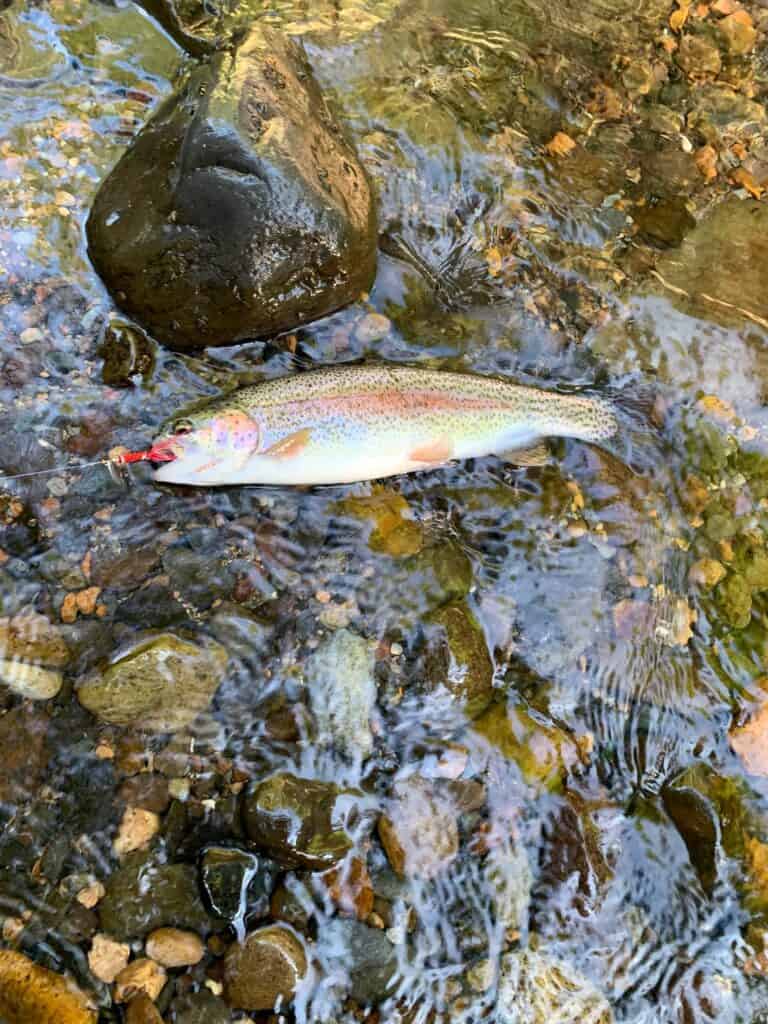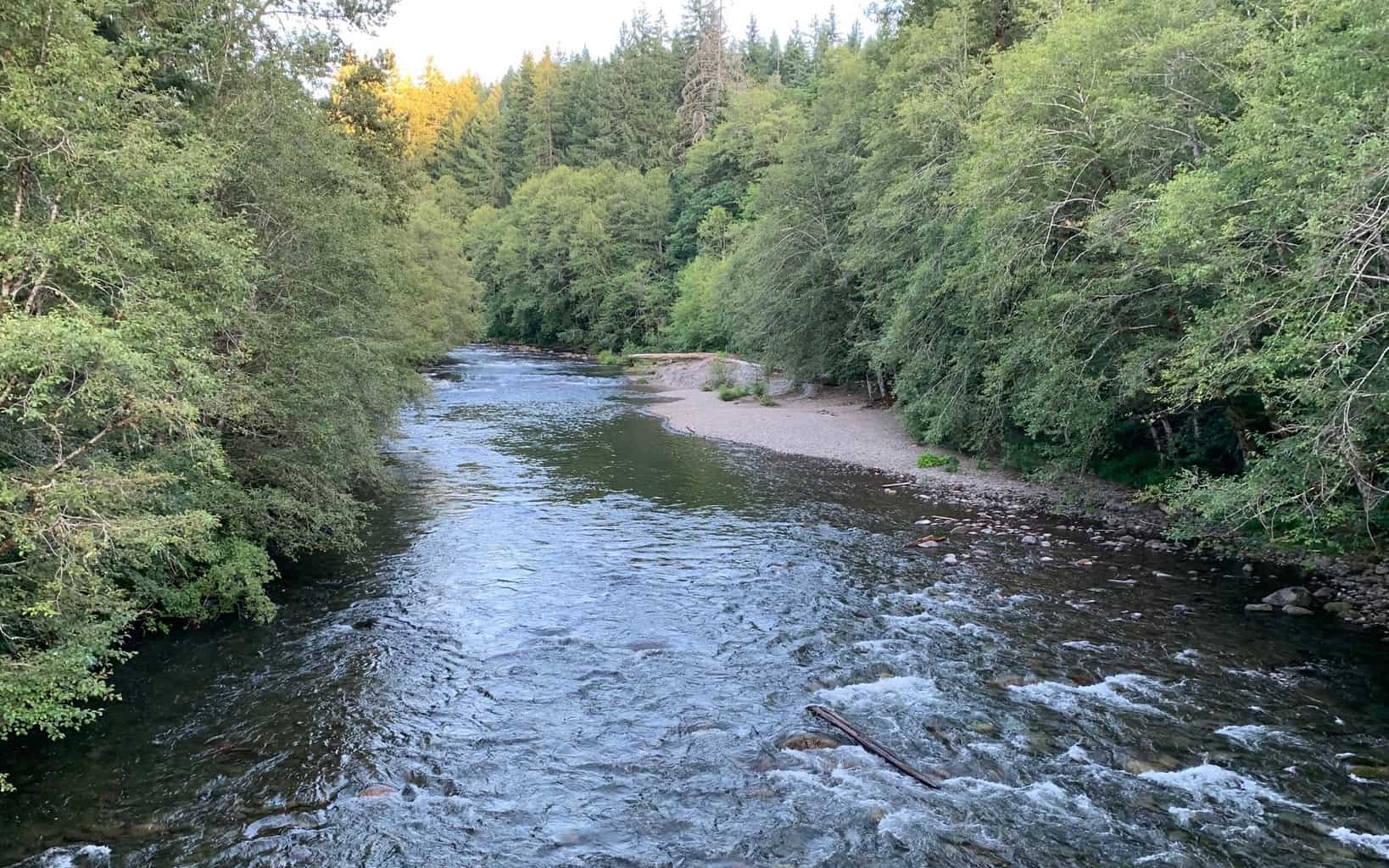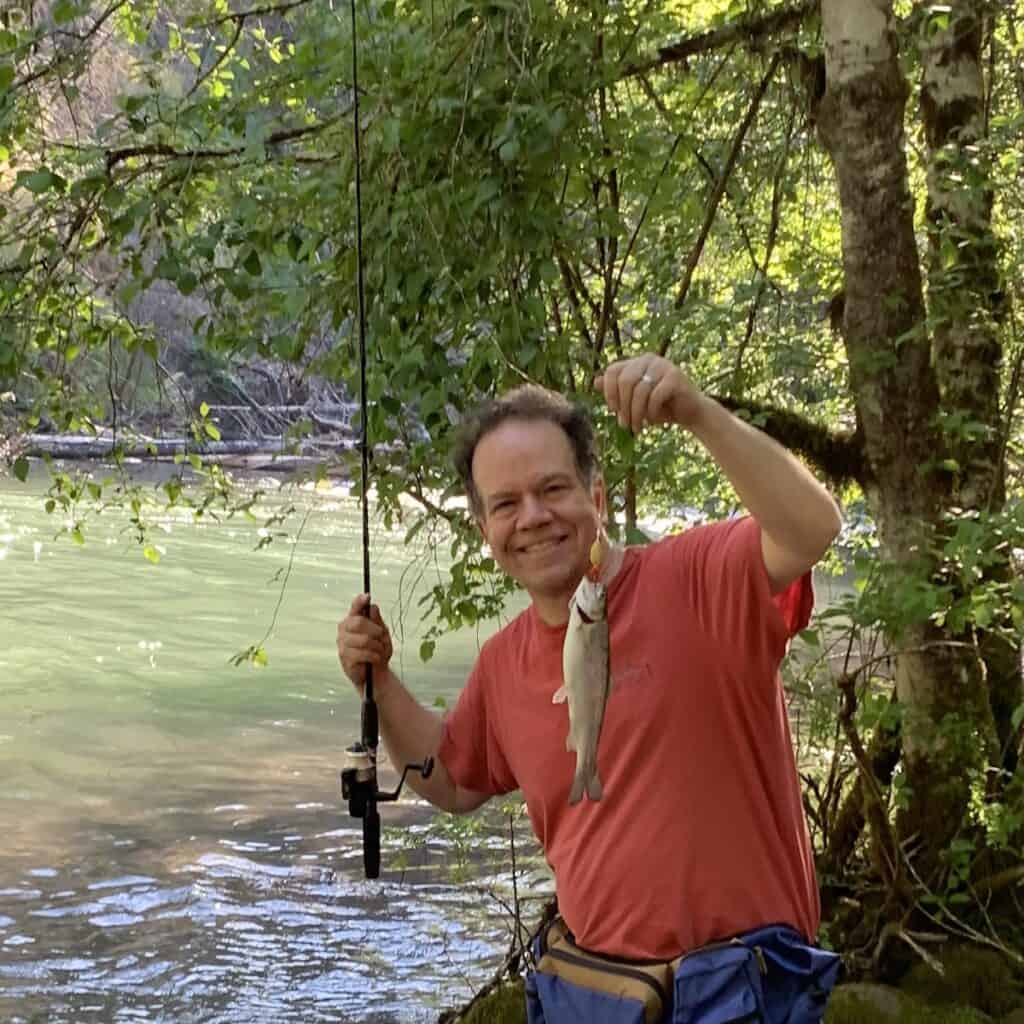Editor’s Notes: This article is regularly updated to include the trout stocking schedule in the North Santiam River above Detroit Lake. See below.
Wildfires in 2020 scarred the banks of parts of the North Santiam River and continue to impact some river access areas below and above Detroit Lake. However, there are spots to fish for major species found in the river.
The Santiam River system in Oregon’s mid-Willamette Valley offers a pleasant variety of salmon, steelhead and trout fishing options, especially during the spring and summer months.
The Santiam is most often fished in its two main forks, known as the North and South Forks, especially for salmon and steelhead runs below the reservoirs.
A modest number of salmon and steelhead are landed in the mainstem, but this section is short, has somewhat limited access, and migrating fish pass through quickly.
At the other end of the system, a good bit of the trout fishing is higher in the Cascade Mountains above the reservoirs.
The North Fork east of Salem feeds Detroit Lake and flows through towns including Mill City and Stayton.
The South Fork and Middle Fork and their tributaries east of Albany and Corvallis fill Green Peter Reservoir and Foster Reservoir before flowing through towns such as Sweet Home and Lebanon.
The forks join into the mainstem just south of the town of Jefferson not far east of Interstate 5, for a relatively short trek to the Willamette River.
This article discusses the major fishing opportunities within the Santiam River system and provides links to more detailed articles about some of those fisheries.
Salmon Fishing
Traditionally, when we talked about salmon fishing here, we mostly talked about hatchery-produced spring Chinook salmon.
In recent years, as the springer runs falter but fall coho make a somewhat surprising surge, the conversation has changed a bit.
In 2023, the upper Willamette River run walloped previous records, topping 40,000 fish over Willamette Falls. Many of those silvers turned left up the Santiam River, and it seems most of those then took another left into the North Santiam.
Coho salmon, it’s worth pointing out, aren’t native to the Willamette River above the falls, but the installation of fish ladders and some long-ago planting of hatchery fish seems to have really taken hold recently.
Coho fishing here is likely to peak around early to mid-fall.
Hatchery spring Chinook salmon continue to be released as smolts to migrate to the ocean and then return as adults that are usually over 10 pounds and sometimes over 20 pounds.
These hard-fighting, unbelievably tasty fish start showing up in April or May, and catches are likely to hit their best levels between Memorial Day and the Fourth of July or a little after. Catches tend to drop off in August.
Both forks can offer excellent spring Chinook fishing when the runs are strong. The South Fork has the hatchery and seems to have the upper hand in catch rates many years, but there have been some years when the North Fork is the more productive choice.
Recent checks find that several hundred of these prized salmon are landed in each fork most years, a far cry from the glory years but still attractive enough for some Willamette Valley anglers.
For more details, including some specific spots to try, read our Willamette Valley Spring Chinook Salmon Fishing article.
Also, check out Best Coho Salmon Fishing Near Portland for information about catching silvers in the Willamette Valley and nearby rivers.
For fall Chinook, we recommend Oregon’s coastal bays and rivers or the Columbia River. Start your search on our Oregon Salmon Fishing index page.
How to Catch Salmon
And when you ready to learn more about HOW to catch salmon in the Pacific Northwest, take a look at our simple guide to effective salmon fishing techniques.
Steelhead Fishing
Like spring Chinook, summer steelhead are a big draw in the Santiam system and overlap the salmon fishing.
These also are reared to smolts in a hatchery before being released in both forks to migrate to the ocean and return as much larger fish.
Summer Steelhead
These are often in the 5- to 15-pound range, with a rare fish even larger. They are excellent fighters, often leaping while trying to shake a hook, and also a very good to eat.
The Santiam system is included in a generous three-hatchery steelhead limit in the upper Willamette River system.
To be honest, getting to that three-fish limit hasn’t been easy in recent years, as summer steelhead runs here in recent years have lagged far below the glory years. That said, the number of steelhead climbing Willamette Falls and heading upstream to tributaries like the Santiams has shown an impressive uptick in 2024.
Unlike Chinook, summer steelhead can live for many, many months in fresh water. Still, most of them will be caught soon after their arrival.
The first fish will be seen in April, but later in May, June and July are often among the best months, especially in the upper areas below the dams, where the water is coolest.
With summer steelhead, the catches continue into fall; in fact, sometimes fishing for summers is very good in about October, when most anglers are focused on catching fall salmon somewhere else.
Note that fishing for hatchery steelhead is open year-round in the primary sections and in the Little North Fork (where a few will stray).
At this writing, ODFW also allows the harvest of wild steelhead during the months of July and August. We recommend using the links in the Resources section to study up on regulations before fishing.
We have more about this fishery, including good spots to try on both forks, in our Willamette Valley Summer Steelhead Fishing article.
Winter Steelhead
Winter steelhead also call the Santiam River system home in pretty good numbers. However, unlike the summer run, this is primarily a wild run of steelhead.
Any steelhead without a clipped and healed-over adipose fin is considered wild and must be released unharmed for most of the year. These may be a thrill to catch, but these runs have struggled in recent years and (although showing positive signs very recently) the ODFW would prefer you leave them alone to spawn and rebuild the runs.
There is only a small chance of finding a fin-clipped hatchery steelhead during the winter season. Typically, fewer than 100 keepers are tagged in either fork or the mainstem during a winter season.
You may catch wild winter steelhead during the early parts of the spring Chinook and summer steelhead seasons but plan to keep a close watch for intact adipose fins and let unclipped steelhead go unharmed.
How to Catch Steelhead
To learn more about catching all steelhead, we have an article that will guide you through the best steelhead fishing methods.
Trout Fishing
There are lots of places to fish for trout in the Santiam River system.
Trout Stocking

While much of the system is managed primarily for wild trout, several upper tributaries are stocked with hatchery rainbow trout and offer outstanding catch-and-keep fishing.
The area with planted trout is the North Fork Santiam above Detroit Lake.
The river up here is a fast-moving, gin-clear trout stream tumbling out of the high Cascades.
The Oregon Department of Fish and Wildlife stocking trucks make weekly stops here during the season, typically from late May into about early August.
The upper river is followed closely by Highway 22, with turnouts that offer stream access.
The primary area stocked in the upper North Fork is from Marion Forks downriver to Detroit Lake.
Some areas that have been regularly stocked include Idanha Bridge, Cooper’s Ridge Road, Riverside Campground, Straight Creek Road Bridge and Downing Creek.
Bait, lure and fly fishing techniques will catch these hatchery planters.
Two other tributary streams within the Santiam River system are currently also seasonally planted with hatchery rainbow trout and offer very good opportunities to bring trout home for dinner.
See our separate articles on the Breitenbush River (North Santiam tributary) and Quartzville Creek (Middle Santiam tributary).
2024 Santiam River Trout Stocking
| Stocking Schedule | Total |
| May 20-24 | 2,200 |
| Jun 10-14 | 2,200 |
| Jun 24-28 | 2,200 |
| Jul 1-5 | 2,200 |
| Jul 8-12 | 2,200 |
| Jul 15-19 | 2,200 |
| Jul 22-26 | 2,200 |
| Jul 29-Aug 2 | 2,200 |
| Aug 5-9 | 2,200 |
Wild Trout
The forks above the reservoirs and many of the tributaries that are open to angling boast pretty good populations of native cutthroat and some wild rainbow trout.
In some areas, wild trout can be harvested, while in others they are strictly catch-and-release. Also note that the use of bait is allowed in some areas but not in others.
The best plan is always to closely read the regulations, which are in linked in the Resources section at the bottom of this article.
Some noteworthy areas to think about for wild trout in the Santiam system include the fishery below the dams on the North Fork, which is primarily fished for wild rainbow and cutthroat trout.
Fin-clipped trout may be retained here, but since trout aren’t actually stocked in this section, hatchery fish here are likely to be steelhead smolts that haven’t migrated out of the river.
The South Fork above Foster Reservoir has a good population of native cutthroat trout that may be fished catch-and-release.
Both of the above sections are popular with fly anglers, but there also are plenty of other waters for trout anglers to explore within this river system that get fairly little angling pressure compared to areas that are stocked.
Brook Trout Fishing
Brook trout, an invasive species, have colonized some areas within the Santiam system, including the North Fork above Detroit Lake.
These fish are most often found in high-mountain streams and lakes, preferring the coldest and clearest water.
Brook trout can be kept in any size or number in some Oregon waters, especially streams such as the North Fork Santiam, but always check regulations to be sure.
And while you’re at it, make sure you know the differences between brook trout and protected native bull trout (ODFW has a comparison in its regulations).
How to Catch Trout
To get a better handle on this big topic, read Trout Fishing: Basic Techniques and Tips.
Smallmouth Bass Fishing
This is another invasive species, but they are good fighters and fun to catch.
In the Santiam River system, where this is a minor fishery, smallmouth bass are found in the mainstem and in the lowest sections of the South Santiam.
Smallmouths will hit soft plastic and crank bait lures, or simply a drifted nightcrawler.
Look for smallmouths behind rocks or other structure or in places where they can get out of the swift current and ambush prey.
If interested in this type of fishing, start with Best Smallmouth Bass Fishing in Western Oregon and follow some of the links there for additional information about where and how to catch these fish.
We also have a nice overview article that will give you all the basics of bass fishing.
Camping
There is a ton of camping available in the Santiam River Watershed.
In the upstream areas, you’ll find plentiful campgrounds and some unimproved sites within the Willamette National Forest.
We personally like the less-crowded stream-side campgrounds in the upper watersheds above the reservoirs, including the areas discussed above that have trout stocking.
Other campgrounds in the watershed are managed by Oregon State Parks, Linn County Parks, and Marion County’s Bear Creek Campground, as well as various private camping and lodging options in the busier areas.
Find more fishing spots in Marion County
Find more fishing spots in Linn County
Oregon Resources
ODFW Weekly Fishing Report
ODFW Trout Stocking Schedule
Oregon Fishing Regulations
National Weather Service


